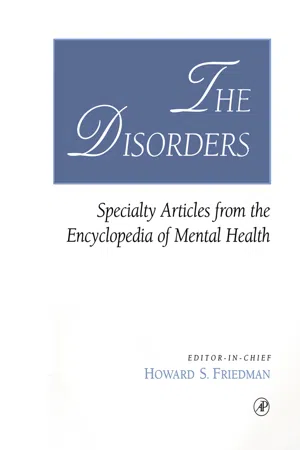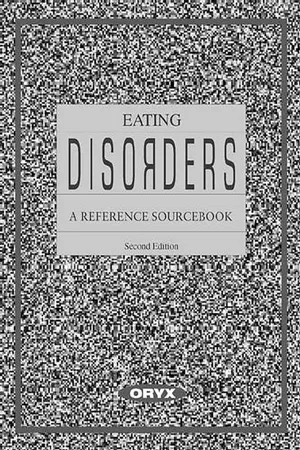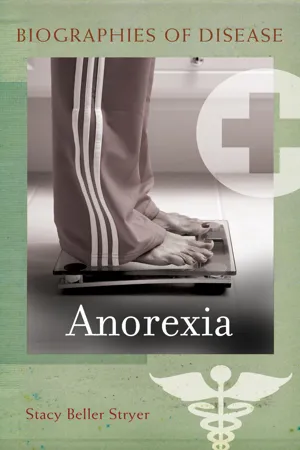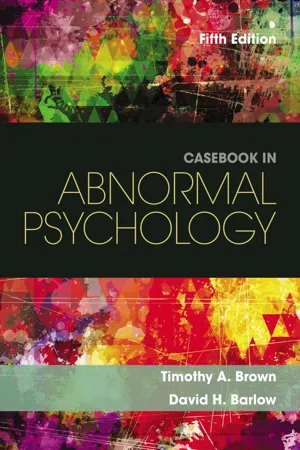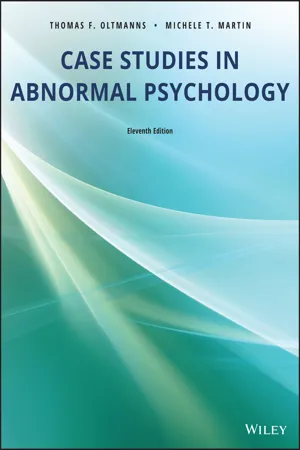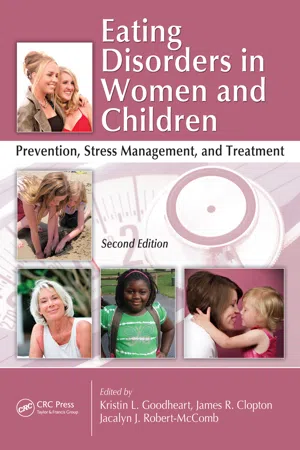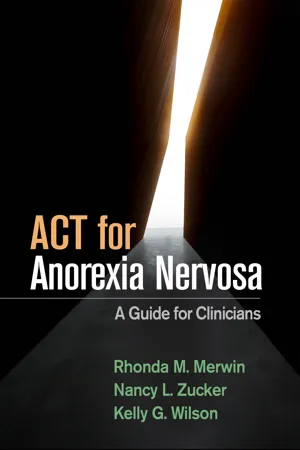Psychology
Anorexia Nervosa
Anorexia nervosa is an eating disorder characterized by an intense fear of gaining weight, distorted body image, and extreme restriction of food intake. Individuals with anorexia often have a relentless pursuit of thinness, leading to severe weight loss and malnutrition. This condition can have serious physical and psychological consequences, and typically requires a comprehensive treatment approach involving medical, nutritional, and psychological interventions.
Written by Perlego with AI-assistance
Related key terms
1 of 5
11 Key excerpts on "Anorexia Nervosa"
- eBook - PDF
Nutrition
Science and Applications
- Lori A. Smolin, Mary B. Grosvenor, Debbie Gurfinkel(Authors)
- 2020(Publication Date)
- Wiley(Publisher)
In recent years there has been a call for the industry to relax its demands on body size. 14 F7.3 Anorexia Nervosa LEARNING OBJECTIVES • Describe the psychological issues that characterize Anorexia Nervosa. • Describe the behaviours associated with Anorexia Nervosa. • Describe the changes in the body that occur as a result of Anorexia Nervosa. • Explain how Anorexia Nervosa is treated. “Anorexia” means lack of appetite, but in the case of the eating disorder Anorexia Nervosa, it is a desire to be thin, rather than a lack of appetite, that causes individuals to decrease their food intake. Anorexia Nervosa was first recognized by physicians in the second half of the nineteenth century. The characteristics of the disorder are described in Table F7.1. It is the most dangerous of the eating disorders. Canadian studies have estimated that Anorexia Nervosa has a mortality rate 10 times higher than that in a comparable healthy population 15 and that the disorder can decrease life expectancy by up to 25 years. 16 Psychological Issues The psychological component of Anorexia Nervosa revolves around an overwhelming fear of gaining weight, even in those who are already underweight (Figure F7.6). It is not uncommon for individuals with Anorexia Nervosa to feel that they would rather be dead than fat. Anorexia Nervosa is also characterized by disturbances in body image or perception of body size that pre- vent those affected from seeing themselves as underweight even when they are dangerously thin. Those with this disorder may use body weight and shape as a means of self-evaluation: many believe that if they weren’t so “fat,” then everyone would like and respect them and that they wouldn’t have other problems, However, no matter how much weight they lose, individu- als with Anorexia Nervosa do not gain self-respect, inner assurance, or the happiness they seek. Therefore, they continue to restrict their intake and use other behaviours in order to lose weight. - eBook - PDF
The Disorders
Specialty Articles from the Encyclopedia of Mental Health
- Howard S. Friedman(Author)
- 2001(Publication Date)
- Academic Press(Publisher)
Anorexia Nervosaand BulimiaNervosa Melissa Peders0nMusseU University of St. Thomas University of Minnesota James E. Mitchell University of North Dakota Medical School Neuropsychiatric Research Institute I. Overview of Eating Disorder Terms II. Continuum of Health Related to Eating Disorders III. Diagnostic Criteria IV. Epidemiology V. Psychological and Social Impairment VI. Medical Complications VII. Detection and Assessment VIII. Treatment IX. Prevention X. Summary Anorexia Nervosa A type of eating disorder asso- ciated with failure to maintain a minimally healthy body weight. Binge Eating Eating large amounts of food in a dis- crete period of time accompanied by a sense of loss of control of food intake. Bulimia Nervosa A type of eating disorder involv- ing recurrent episodes of binge eating and compen- satory behaviors (e.g., purging, fasting, or excessive exercise). Eating Disorder A category of psychiatric disorders involving disturbances in eating patterns and attitudes toward food and body image. Purging A method of compensating for dietary in- take, most commonly by self-induced vomiting, laxa- tive abuse, or diuretic abuse. Anorexia Nervosa AND BULIMIA NERVOSA are two of the most commonly recognized eating dis- orders. The term eating disorder encompasses a va- riety of psychological/psychiatric disorders involving 57 disturbed eating patterns and attitudes toward food and body image. Unhealthy weight control practices and intense body image distortion or disparagement are central features of eating disorders. I. OVERVIEW OF EATING DISORDER TERMS The word nervosa indicates that each of these con- ditions is a nervous disorder. Psychological difficul- ties are likely to be involved in the development of these disorders, and also are likely to be exacerbated by the eating-disordered behavior. Anorexia means lack of appetite. The hallmark feature of Anorexia Nervosa (AN) is failure to maintain a minimally nor- mal body weight. - eBook - PDF
Psychosomatics
The Uses of Psychotherapy
- Peter Shoenberg(Author)
- 2017(Publication Date)
- Red Globe Press(Publisher)
6 Anorexia Nervosa and Bulimia Nervosa Anorexia Nervosa I still have not been able to alter my attitude and approach to food and eating; I feel it is a struggle with which I alone must cope . . . Closely tied with problems of mealtimes are my fabrications or value judgements of types of food and the imposition of 'oughts' as to the amount I 'should' eat ... In trying to cope with the task of eating a balanced diet I have found myself most dependent on, and in rebellion against, my parents, most especially my mother ... I feel a failure and have a need to be in control ... and I struggle with the prob-lem of dependence and independence . . . Outwardly I readily acknowledge that I am thin, tired, physically unattractive, and that I should gain some weight; but when it comes down to practical tasks, emotional reactions usually predominate. Letter from a young anorexic to Hilde Bruch, quoted in Conversations with Anorexics (Bruch, 1988) The term 'Anorexia Nervosa' was introduced by Gull (1873) and Lasegue (1873) who asswned that this was a condition in which the appetite disappeared. It was not until 1895 that Gilles de la Tourette recognized the ravenous and frightening nature of the hunger his patients experienced. By the 1940s this denial of hunger was connected with the fear of becoming fat. Patients with Anorexia Nervosa continually engage in patterns of behaviour that maintain or increase a marked weight loss (DSM-IV-TR requires less than 85 per cent of healthy weight; the ICD-10 criterion of a Body Mass Index of less than 17.5 is commonly used, measured by dividing the weight (in kg) of an individual by the height in metres squared). This is an uncommon disorder with a prevalence of about 1 in 1,000 (Jones et al., 2001). Sufferers try to get rid of their food intake and decrease 97 98 PSYCHOSOMATICS excessively intake of high carbohydrate or fat-containing foods. Some engage in rigorous exercise programmes. Others may be active at all times. - eBook - PDF
Eating Disorders
A Reference Sourcebook
- Raymond Lemberg, Leigh Cohn(Authors)
- 1998(Publication Date)
- Greenwood(Publisher)
PART1 Understanding Eating Disorders: Symptoms and Causes The Eating Disorders: An Introduction by Barbara P. Kinoy, Ph.D., Adele M. Holman, D.S.W., and Ray Lemberg, Ph.D. This chapter discusses the three eating disorders— Anorexia Nervosa, bulimia nervosa, and binge eat- ing disorder (also referred to as compulsive over- eating)—as well as "the obesities." For additional information, please see Adrien H. Thurstin's chap- ter, "Behavioral, Physical, and Psychological Symptoms of Eating Disorders," beginning on page 12. Anorexia Nervosa Anorexia Nervosa is an eating disorder character- ized by a purposeful weight loss far beyond the normal range. Fear of being fat is almost always an overriding factor in this pursuit. A desire to perfect one's self through one's body, and by ex- tension in every other way, is also a strong char- acteristic and can supersede the reality of body structure and function, resulting in a distorted body image. This pursuit can also displace or change other requirements of living, such as family and social relationships. Listed below are behavioral, physical, and emotional symptoms and changes that are a part of the picture of Anorexia Nervosa. Symptoms of bulimia nervosa, or bulimia, will also be reviewed. Similar to Anorexia Nervosa, bulimia has often been linked with it, and the discussion of each will be overlapping. Finally, binge eating disorder will be discussed. Keep in mind, however, that people do not always fit exactly into the categories of anor- exia, bulimia, or binge eating disorder, and thus the line between them may be a fine one. Anorexia Nervosa is officially classified into two categories: (1) the restricting type (character- ized by low calorie intake and the absence of binge-eating or purging behavior) and (2) binge- eating/purging type (characterized by calorie re- striction and binge and/or purge behaviors). SYMPTOMS OF Anorexia Nervosa Intense fear of becoming obese, which does not diminish as weight loss progresses. - eBook - PDF
What Works for Whom?, Second Edition
A Critical Review of Psychotherapy Research
- Anthony Roth, Peter Fonagy(Authors)
- 2013(Publication Date)
- The Guilford Press(Publisher)
C H A P T E R 9 EATING DISORDERS Anorexia Nervosa, Bulimia Nervosa, and Binge-Eating Disorder DEFINITIONS DSM-IV-TR assumes a diagnostic primacy for Anorexia Nervosa; on this basis, a diagnosis of bulimia nervosa can only be applied in the absence of anorexic features. Anorexia Nervosa The essential feature of this disorder is a refusal to maintain body weight at or above a minimally “normal” body weight; this is defined as a body weight 15% below that expected for the individual’s age and height. To meet diagnostic criteria, there must also be an intense fear of becoming fat, even though underweight; a severe restriction of food intake, often with excessive exercising, in order to achieve weight loss; a disturbance in the way in which body weight or shape is experienced, and an undue influ- ence of body weight or shape on self-evaluation; and (in postmenarcheal women) amenorrhea. There are two subtypes of Anorexia Nervosa—binge-eating/purging type, in which there is regular binge eating or purging (self-induced vomit- ing, or use of laxatives or diuretics), and restricting type, in which these behaviors are not present. 236 Bulimia Nervosa The main feature of this disorder is recurrent episodes of binge eating asso- ciated with a lack of control over eating behavior during the binges. Self- induced vomiting, use of laxatives or diuretics, and strict dieting or ex- cessive exercise are often associated features, together with a persistent preoccupation with body size and shape. At least two binges a week over a period of 3 months are required to make this diagnosis. As with Anorexia Nervosa, self-evaluation is excessively linked to ideas about body weight and shape. DSM-IV-TR subtypes bulimia nervosa to purging type, in which vom- iting or purging occurs, or nonpurging type, in which excessive fasting or exercise occurs but without purging. - 3 Defining Anorexia Nervosa and How It Is Diagnosed ‘‘No matter how thin I was my stomach always bothered me. It was sunken in, yet I always saw it bulging with imaginary fat. All I focused on was diminishing the fat.’’ —Ari I t has been over a century since Anorexia Nervosa was first well-described, yet it is still not completely understood how someone develops it or the best way to treat it. In fact, experts do not completely agree on the most accurate way to diagnose this eating disorder and, consequently, its exact definition continues to change. Although there is still much to be discovered, we have already learned a great deal about anorexia, making it easier to iden- tify now than in the past. For instance, it is known that those afflicted with anorexia, mostly females, have a significant weight loss that often goes unno- ticed for months or longer by everyone, including family, friends, and physi- cians. Even the individual who develops it may not realize at first that she is losing so much weight. This illness usually begins as a diet which then takes on a life of its own and leads to a downward spiral, where the initial weight goal has come and gone, and newer, lower target weights are constantly being attained. CRITERIA USED FOR DIAGNOSING Anorexia Nervosa Anorexia was described in the 1800s and physicians have been treating it for over a century. Yet, it was not classified as a mental illness until 1980 when the American Psychiatric Association first published the criteria used to diagnose Anorexia Nervosa in the third edition of its Diagnostic and Statistical Manual of Mental Disorders (DSM-III). The DSM is the reference book most commonly used by mental health professionals in the United States and in other parts of the world to classify and diagnose mental and psychiatric condi- tions. The current manual is the DSM-IV-TR (fourth edition, text revision) (American Psychiatric Association 2000).
- eBook - PDF
- Timothy Brown, David Barlow(Authors)
- 2016(Publication Date)
- Cengage Learning EMEA(Publisher)
In DSM-5 , the key fea-tures of Anorexia Nervosa are (a) restriction of energy intake relative to require-ments, leading to a significantly low body weight (i.e., weight that is less than minimally normal) in context of age, sex, developmental trajectory, and physical health; (b) intense fear of gaining weight or of becoming fat, or persistent behavior that interferes with weight gain, despite being at a significantly low weight; and (c) disturbance in the way in which one ’ s body weight or shape is experienced, undue influence of body weight or shape on self-evaluation, or persistent lack of recognition of the seriousness of the current low body weight. Patty clearly exhibited each of the diagnostic features of Anorexia Nervosa. Given her lowest body weight below 70% of ideal and her current body weight of 80% of ideal, Patty met the first DSM-5 criterion; that is, she restricted her food intake to achieve and maintain a body weight that was significantly below what would be normal for her sex and age group. She met the second criterion, showing an intense fear of gaining weight or becoming fat, although she was underweight. Because she reported nothing was more important to her self-evaluation than weight and shape, and because she felt fat despite being underweight, Patty met the third criterion for Anorexia Nervosa. In DSM-5 , the diagnosis of Anorexia Nervosa can be assigned with the follow-ing subtypes: restricting type, and binge-eating / purging type. The restricting type pertains to clinical presentations in which weight loss is accomplished primarily through dieting, fasting, or excessive exercise. For this subtype to apply, the individ-ual must not have engaged in recurrent episodes of binge eating or purging in the prior 3 months. The binge-eating/purging type is appropriate to use when the indi-vidual has regularly engaged in binge eating and/or purging during the past 3 months (see Case 11 for a clinical description of binge eating and purging). - eBook - PDF
- Thomas F. Oltmanns, Michele T. Martin(Authors)
- 2018(Publication Date)
- Wiley(Publisher)
Many researchers and clinicians have described perfectionism as common among people with anorexia (Franco‐Paredes, Mancilla‐ Díaz, Vásquez‐Arévalo, López‐Aguilar, & Álvarez‐Rayón, 2005). A frequent feature of anorexia is overactivity. People with the disorder are often restless and engage in excessive exercise (Klein & Walsh, 2004). Risk factors in early adolescence for later developing Anorexia Nervosa include negative emotions and a lean body type; perhaps they are ambivalent to food or already have a tendency to undereat (Stice, Gau, Rohde, & Shaw, 2017). Joan met the diagnostic criteria for Anorexia Nervosa, binge‐eating/purging type. She experi- enced a drastic, self‐induced loss of weight; was intensely afraid of becoming fat; and could not recognize the true size of her body or the seriousness of her condition. In addition to her severe restriction of food intake, Joan would also periodically eat large amounts of food and then try to rid herself of the unwanted calories through vomiting and laxatives. She also experienced many of the physical side effects that accompany starvation, such as loss of menstruation, skin changes, constipation, hypotension, bloating, abdominal pains, dehydration, and lanugo (downy hair growth). Some of the psychological symptoms of Anorexia Nervosa are produced by the lack of food and are not necessarily inherent aspects of the anorexic’s personality. For example, people who are starving become preoccupied with food and eating. Like Joan, they will often cook for others, read recipe books, and may even develop peculiar food rituals. While people with anorexia ner- vosa may become preoccupied with interacting with food, they lose their motivational orienta- tion toward eating it (Veenstra & de Jong, 2011). This lack of desire to approach and consume food is what enables them to so severely restrict their food intake. Obsessive behaviors, such as hoarding, may also appear. - eBook - PDF
Progress in Behavior Modification
Volume 19
- Michel Hersen, Richard M. Eisler, Peter M. Miller, Michel Hersen, Richard M. Eisler, Peter M. Miller(Authors)
- 2013(Publication Date)
- Academic Press(Publisher)
The American Journal of Gastroenterology, 74, 127-132. Salkind, M. R., Fincham, J., & Silverstone. (1980). Is Anorexia Nervosa a phobic disorder? A psychophysiological inquiry. Biological Psychiatry, 15, 803-808. Schachter, S. (1971). Some extraordinary facts about obese humans and rats. American Psychologist, 26, 129-144. Schachter, S., Goldman, R., & Gordon, A. (1968). Effects of fear, food deprivation, and obesity on eating. Journal of Personality and Social Psychology, 10, 98-106. Schnurer, A. T., Rubin, R. R., & Roy, A. (1973). Systematic desensitization of Anorexia Nervosa seen as a weight phobia. Journal of Behavior Therapy and Experimental Psy-chiatry, 4, 149-153. Shipman, W., & Sohlkhah, N. (1967). Body distortion in obese women. Psychosomatic Medicine, 29, 540 (abstract). Silverman, J. A. (1974). Anorexia Nervosa: clinical observations in a successful treatment plan. Journal of Pediatrics, 84, 68-73. Silverstone, J. T., & Russell, G. F. M. (1967). Gastric hunger contractions in Anorexia Nervosa. British Journal of Psychiatry, 113, 257-263. Slade, P. D. (1973). A short anorexic behaviour scale. British Journal of Psychiatry, 122, 8 3 -85. Slade, P. (1982). Towards a functional analysis of Anorexia Nervosa and bulimia nervosa. British Journal of Clinical Psychology, 21, 167-179. Slade, P. D., & Russell, G. F. (1973). Awareness of body dimensions in Anorexia Nervosa: Cross-sectional and longitudinal studies. Psychological Medicine, 3, 188-199. Smart, D. E., Beumont, P. J. V., & George, G. C. W. (1976). Some personality characteris-tics of patients with Anorexia Nervosa. British Journal of Psychiatry, 128, 57-60. Solyom, L., Freeman, R. J., & Miles, J. E. (1982). A comparative psychometric study of Anorexia Nervosa and obsessive neurosis. Canadian Journal of Psychiatry, 27, 282-286. Spencer, J. Α., & Fremouw, W. J. (1979). Binge eating as a function of restraint and weight classification. Journal of Abnormal Psychology, 88, 262-267. Stonehill, E., & Crisp, A. - eBook - PDF
Eating Disorders in Women and Children
Prevention, Stress Management, and Treatment, Second Edition
- Kristin Goodheart, James R. Clopton, Jacalyn J. Robert-McComb, Kristin Goodheart, James R. Clopton, Jacalyn J. Robert-McComb(Authors)
- 2011(Publication Date)
- CRC Press(Publisher)
Additionally, anxiety and mood disorders affect about 25% of people with AN (Steinhausen 2002), and comorbid conditions like depression, anxiety, phobias, and personality disorders might contrib-ute to worse outcomes for AN patients (Steinhausen 2002). 1.3.1.1 Diagnostic Criteria for Anorexia Nervosa DSM-IV-TR (APA 2000) includes specific diagnostic criteria for AN. Initially, the individual must be at a weight that is 85% or less of her expected weight, based on her height and her age. Additionally, individuals who have started menstruating will develop amenorrhea. For those girls who have not reached menarche, they will typically fail to begin menstruating at the expected time. Psychological criteria include extreme disturbance in self-perception of the body and an overwhelming fear of fatness. AN patients can be further subdivided into two subtypes: restricting subtype (AN-R) and binge/purge subtype (AN-BP). The AN-R subtype describes those individuals who severely restrict their food intake and do not use compensatory behaviors, like self-induced vomiting, to compensate for calories consumed. The AN-BP subtype is diagnosed when periods of restriction are accom-panied by periods of overeating and extreme compensatory purging behaviors, like self-induced vomiting. Some question the validity of the diagnostic criteria for AN that are included in the DSM-IV-TR. The strongest debate has risen regarding the inclusion of amenorrhea . Some suggest that the differ-ences between AN patients who do and do not menstruate are very limited (Cachelin and Maher 1998; Garfinkel et al. 1996; Striegel-Moore and Marcus 1995). Additionally, a large number of females use birth control or other substances that affect hormones, so it can be difficult to determine if a woman would develop amenorrhea if she were not using these substances (Herpertz-Dahlmann 2008). - eBook - PDF
ACT for Anorexia Nervosa
A Guide for Clinicians
- Rhonda M. Merwin, Nancy L. Zucker, Kelly G. Wilson(Authors)
- 2019(Publication Date)
- The Guilford Press(Publisher)
More likely, they feel ineffective and shameful about their inability to interact with others. The ability to override hunger is also highly visible, and thus it serves social functions, solidifying the individual’s status, or oth- erwise affecting the behavior of other people. Individuals with AN often describe receiving compliments, attention, caretaking, and other social benefits. Thus, they feel like a good or better person and their behavior is reinforced by other people. Together, these more CHAPTER 1 The Phenomenology and Conceptualization of Anorexia Nervosa from an ACT Perspective 10 ACT FOR Anorexia Nervosa immediate and emotionally charged contingencies are often far more compelling than the delayed negative consequences of low weight (e.g., decreased bone density). Although AN might be driven initially by psychological factors, it may persist because of the incredible impact of starvation on the brain and the body. In the famous case of Saint Catherine (one of the earliest well-documented cases of self-starvation), the church became concerned about her safety and urged an end to her fast, stating that it was inconsistent with biblical tenets. However, she continued to withhold food and eventually died. Like a ball rolling downhill, starvation begets starvation as undernourishment impairs the indi- vidual’s ability to change course. Individuals who are nutritionally depleted evidence struc- tural brain abnormalities (e.g., enlarged ventricles) and have difficulty reasoning, shifting attention flexibly, and adapting behavior to changing contingencies, with increased rigid- ity and obsessionality often beyond premorbid levels. Biological adaptations to starvation further perpetuate the problem. Attention narrows to food and the individual experiences less interest and pleasure in social interactions or other activities.
Index pages curate the most relevant extracts from our library of academic textbooks. They’ve been created using an in-house natural language model (NLM), each adding context and meaning to key research topics.

